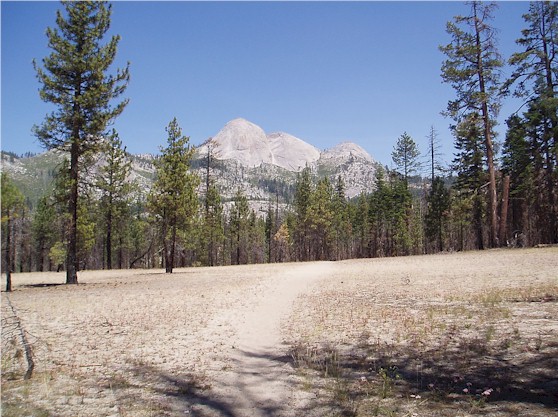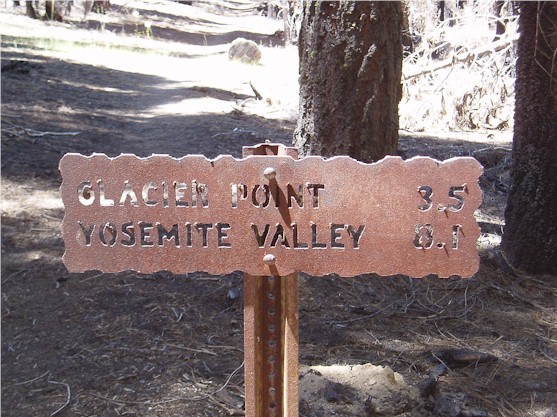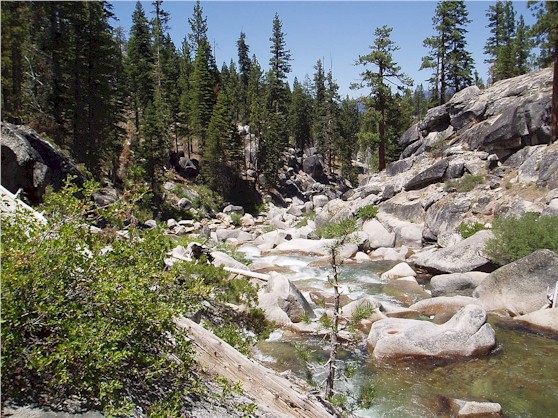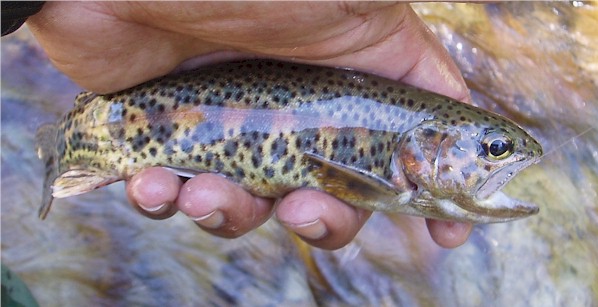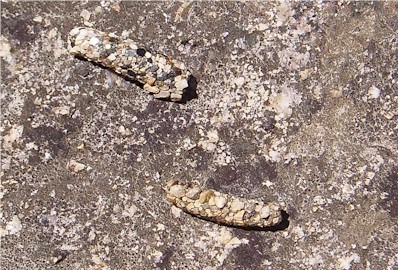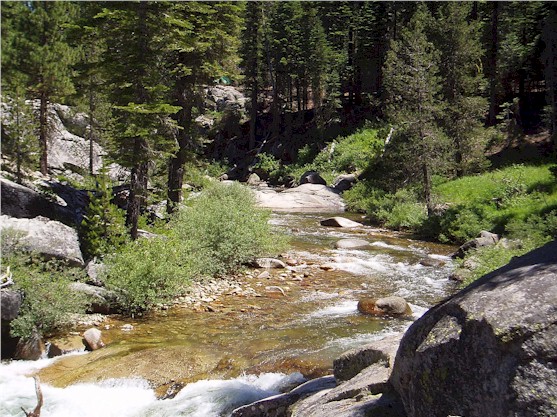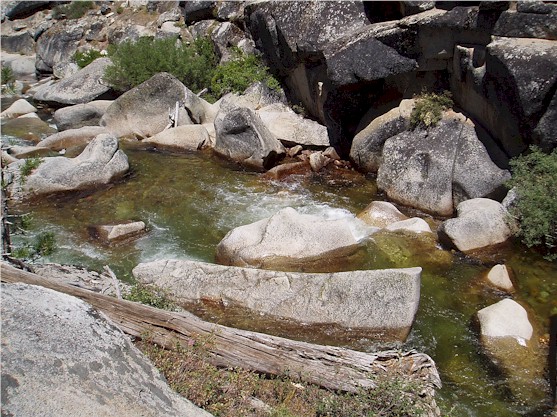|
|
|
|
|
July 15th, 2006- Illilouette Creek Time:
Early Afternoon to Early Evening Narrative:
Some years ago, I can't remember just how many, I read Steve Becks Yosemite Trout Fishing cover to cover. If you have it but have not read it, you need to. It's the kind of book that you can't use as a reference book. It has to be read cover to cover and the pertinent information has to be highlighted if you are ever to find it again.
And that's exactly what I did. Now when I'm planning to fish an area, I just reference the highlighted areas and I'm off. On page 57 or 58 of that book, I have two highlights of interest- Illiloutte Creek and Golden Trout . That was enough to get the nod as today's destination of discovery.
Illilouette Creek, known by the native Miwok as Tu-lu-la-wi-ak until some knucklehead explorer named it "Illiloutte" (a bogus Indian name) lies behind the famous Half Dome. It's fish, according to the book, were not Golden Trout but Golden/Rainbow hybrids and I was intrigued. I'm not sure I caught any Golden Rainbow hybrids, sure, some of the fish had a slightly orange belly but the more colorful fish looked more like what I'd imagine a Lahontan/ Rainbow hybrid would look. They were fun all the same.
I got a late start on Saturday and didn't arrive at the trailhead until 12:30pm. I didn't really know the terrain but I did know that I cross a couple of feeder streams before reaching the main stem of the creek. I had planned to hike to the creek or until 2:00pm. Whichever came first.
From the trailhead, the trail heads straight down into a canyon, through a dense conifer forest, skirts a swampy meadow, down some more to a stream crossing, up over a saddle and down into another canyon. The hike was a quick one and I was fishing by 2:00pm.
The trail met the creek just as it entered into a deep canyon. The water was a tad high and crystal clear. I hiked downstream a bit to where it looked like I could safely enter the canyon. Once at the water I pulled out my hip boots and geared up.
I was really looking forward to dry fly fishing and immediately put on an Elk Hair Caddis and scoured my pack looking for fly floatant. I checked and rechecked my pack and there was none to be found. I couldn't believe it. I distinctly remembered filling my pack two weeks ago and making it a point NOT to forget my floatant. I couldn't believe it.
I tried to use ChapStick as floatant but that really doesn't work. Still, my ChapStick covered fly caught plenty of fish. The canyon water was deep and I couldn't wade far before the stream dropped off. I was drying my EHC in my shirt when I happened to notice a fish working in front of a rock below and to my right. The rock formed the perfect pressure cushion in front of it, deep and still. The fish apparently didn't see me as I made a short cast, stopping the rod tip high and dropping the tip to induce slack in the leader. The fly had two seconds of drift before the currents pulled it to the side but that was all I needed. That first fish was by far the best- good size, nice colors, nice little fight and a challenging presentation- in other words, a lot fun.
I found myself trying a bunch of different flies looking for the best floater but always reverted back to the EHC, which floated best and caught the most fish. As I made my way upstream, I was perfectly content with catching the smallish 5 - 8 inch fish I seemed to be catching. Content, that is, until I came across a rock with large caddis cases. I was a little taken a back at first. These cases where October Caddis sized but any October Caddis cases would have been washed away buy the spring run off. Whatever made these cases had recently hatched. I quickly checked the water and found very large, cream orange cased caddis everywhere! I'm not sure what they were but they were big and plentiful and this meant that there had to be large fish in this stream somewhere.
I went on a hunt for big fish. At the first deep pool that certainly screamed big fish...none were found. Instead I found Berkeley Power Grubs. I'd imagine the Power Grubs work well as they are about the size of the caddis. I also imagine that a lot of the big fish have been "harvested", are in hiding or moved elsewhere.
As I continued up stream I soon became aware that this stream, or at least this part of the stream, was fairly popular. Why wouldn't it be? It was only 3 miles from the trailhead. At first I saw one person and then two and then four. One even tried to communicate with me but I couldn't hear him over the roaring water. As best as I could tell, he'd lost one of his boots and it was drifting down stream.
I was the only one fishing and the fishing was fine but if I wanted to catch larger fish, I'd probably do better upstream. My "bigger" fish quest was somewhat successful as I picked up a few 10 inch fish, but I've got to imagine that there are a few 14 inch bruisers in this stream. The stream isn't extremely high 6,500ft, there's plenty of food and it didn't seem overly crowded, though there were plenty of tiny fish. So many I got to a point that if the fish didn't look to be 6 inches or greater, I'd simply let the fish mouth the fly and continue fishing.
As always when hiking alone, I had a travel plan and that plan had me fishing until 4:00pm or 4:30pm so I would not be caught in the canyon when the sun went down. Sun set was at 8:22pm but in the canyon it would set much closer to 6:45pm. Let me tell you, it was tough leaving this stream. I could feel that there were larger fish in the stream and the constant drying and re-drying of my fly meant that I had covered about 1/3 of the water that I would normally have fished in 2 hours.
4:00 pm became 4:15pm and then 4:30pm. I was tempted to stay. I had raised a good size fish and was confident I could catch it. I'd already pricked it twice in 20 min and knew if I just rested the fish and came back, I would have another shot. I needed more time. Time I'd forfeited earlier in the day when I decided to leave 2 hours late, which translated to 3.5hrs at the trail due to tourist traffic.
The shadows were starting to get long and after making my 15th "last cast", I made my way out. The hike out was tough, as I knew it would be. On the way in I'd made note of the very steep sections and mentally added the additional 20 or 30 min I would need to climb each section.
On my way out, I'd lashed my jacket to the outside of my pack in case I got a chill. Every so often I'd put my hand behind me to make sure the jacket hadn't fallen off. I was up the first small hill about a half a mile from the stream when I put my hand back for the first time and felt a small cylinder...I'd placed my fly floatant in the pocket of my jacket. A jacket I had planned on wearing while fishing two weeks earlier when the weather was colder. A jacket in which I'd keep my fly floatant on earlier trips this year and a jacket whose pocket I didn't even think to look in this day.
Previous Yosemite / Ansel Adams Wilderness Chronicle Next Yosemite/Ansel Adams Wilderness Chronicle
|

